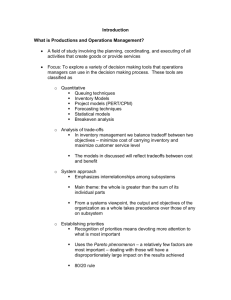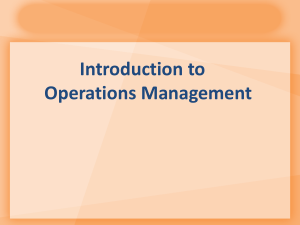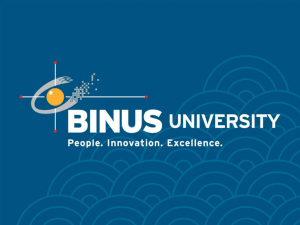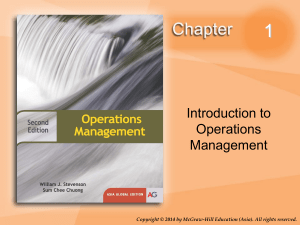Introduction to operations Management
advertisement
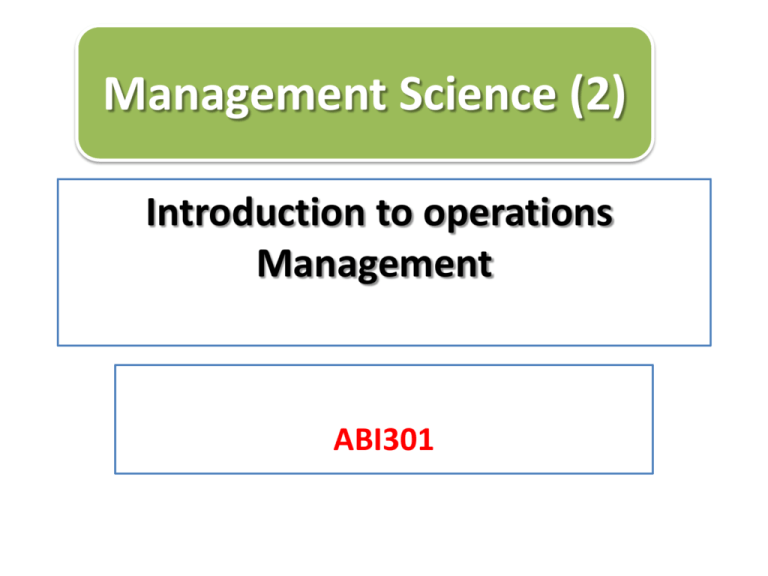
Management Science (2) Introduction to operations Management ABI301 Definition • Operations management is the management of that part of an organization that is responsible for producing goods and/or services. • There are examples of these goods and services all around you. • Everything you wear, eat, travel in, sit on, and access the Internet with are good examples. Basic functions of business organizations • Business organizations typically have three basic functional areas Finance • Finance is responsible for: 1. securing financial resources at favorable prices 2. allocating those resources throughout the organization 3. budgeting, analyzing investment proposals 4. providing funds for operations • Marketing is responsible for: 1. assessing consumer wants and needs 2. selling and promoting the organization’s goods or services. • Operations is primarily responsible for: 1. producing the goods 2. providing the services offered by the organization 3. operations is the core of what the organization does • operations management is the management of systems or processes that create goods and/or provide services. • The creation of goods or services involves transforming or converting inputs into outputs • To ensure that the desired outputs are obtained, measurements are taken at various points in the transformation process (feedback) and then compared with previously established standards to determine whether corrective action is needed (control) • Value-added is the term used to describe the difference between the cost of inputs and the value or price of outputs. • Finance and operations management personnel cooperate by exchanging information and expertise in such activities as the following: 1. Budgeting. Budgets must be periodically prepared to plan financial requirements. Budgets must sometimes be adjusted, and performance relative to a budget must be evaluated. 2. Economic analysis of investment proposals. Evaluation of alternative investments in plant and equipment requires inputs from both operations and finance people. 3. Provision of funds. The necessary funding of operations and the amount and timing of funding can be important and even critical when funds are tight. Careful planning can help avoid cash-flow problems. Organizational functions Thus, marketing, operations, and finance must interface on product and process design, forecasting, setting realistic schedules, quality and quantity decisions, and keeping each other informed on the other’s strengths and weaknesses. 1. Accounting – Provides information to management on costs of labor, materials, and overhead, and may provide reports on items such as scrap, downtime, and inventories. 2. Management information systems (MIS) is concerned with providing management with the information it needs to effectively manage. 3. The personnel or human resources department is concerned with recruitment and training of personnel, labor relations, contract negotiations, wage and salary administration, assisting in manpower projections, and ensuring the health and safety of employees. 4. Public relations has responsibility for building and maintaining a positive public image of the organization. Good public relations provides many potential benefits. 5. The legal department must be consulted on contracts with employees, customers, suppliers, and transporters, as well as on liability and environmental issues. 6. Purchasing – procurement of raw materials Stage 1 • System design – decisions on system capacity, location of facilities, arrangement of department, acquisition of equipment usually involves decision that are for long-term use. Stage 2 • System Operation- decision on management of personnel, inventory planning and control, scheduling, project management, quality control • Production of goods results in a tangible output, such as an automobile, eye glasses, a golf ball, a refrigerator anything that we can see or touch. • It may take place in a factory, but can occur elsewhere. For example, farming produces nonmanufactured goods. • Delivery of service, on the other hand, generally implies an act. A physician’s examination, TV and auto repair, lawn care, and projecting a film in a theater are examples of services. The majority of service jobs fall into these categories: 1. Government (federal, state, local). 2. Wholesale/retail (clothing, food, appliances, stationery, toys, etc.). 3. Financial services (banking, stock brokerages, insurance, etc.). 4. Health care (doctors, dentists, hospitals, etc.). 5. Personal services (laundry, dry cleaning, hair/beauty, gardening, etc.). 6. Business services (data processing, e-business, delivery, employment agencies, etc.). 7. Education (schools, colleges, etc.). Transformation Process - Examples Manufacturing and service organizations differ chiefly because manufacturing is goods oriented and service is act-oriented. The differences involve the following: 1. Degree of customer contact (service involves a much higher degree of customer contact). 2. Uniformity of input (Service operations are subject to greater variability of inputs) 3. Labor content of jobs (Often services involving a higher labor content) 4. Uniformity of output (in manufacturing there is less variability in final product) 5. Measurement of productivity (productivity is more straightforward in manufacturing) 6. Production and delivery (often customers receive the service as it is performed) 7. Quality assurance (is more challenging in services when production and consumption occur at the same time) 8. Amount of inventory (Due to the nature of manufacturing, manufacturing systems usually have more inventory on hand ) • Mass production • Producing large volume of standardized products/goods, produced by low skilled or semi skilled workers, using highly specialized and expensive equipment. • Lean Production • Lean production - uses minimal amount of resource to produce high volume of high quality goods with some variety. • Craft Production • Using highly skilled workers using simple, flexible tools to produce small quantities of customized goods



